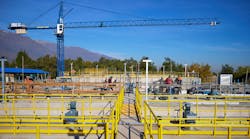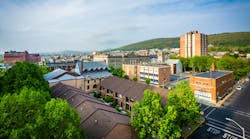Power plants and industrial facilities in the U.S discharge more than 400 billion gal per day of wastewater. Much of this water can be reused rather than discharged, creating a multibillion-dollar-per-year opportunity for suppliers of treatment chemicals, filters, clarifiers, pumps and valves.
Utility and industrial power plants offer the biggest opportunity for water reuse. The average utility plant is located within 70 miles of a municipal wastewater treatment plant; therefore, the transport of the treated wastewater to the power plant is not expensive. Minimal treatment is necessary for use as cooling water in the power plant.
The co-location of sewage treatment plants and plants with steam requirements is ideal. The power plant can supply waste steam to improve the efficiency of the municipal wastewater treatment operations. The municipal treated wastewater is used by the power plant along with the sewage sludge. This sludge replaces some of the solid fuel otherwise required.
Semiconductor Manufacturing
Many other industries can benefit from either reusing their own wastewater or using municipal wastewater. It also is possible to use wastewater from other industrial operations.
The use of water is vital to the manufacturing of semiconductors. An integrated circuit on a 300-mm wafer requires approximately 2,200 gal of water in total, of which 1,500 gal is ultrapure water (UPW).
The semiconductor industry spends approximately $1 billion each year on water and wastewater systems. Much of it goes into UPW production from city water. A semiconductor fabrication plant (fab) may use between 2 to 4 million gal of UPW every day.
In many places, the expansion of semiconductor production is restricted due to a limited water supply. The cost of water and surcharges for excessive consumption or discharge are growing.
For every dollar a fab spends on supplied water, $20 is spent treating it to an ultrapure quality, and another $10 is spent to treat the discharge.
Approximately 46 kWh are recovered for every 1,000 gal of UPW conserved. For a system using 3 million gal of UPW, reducing UPW by 10% can save the plant more than $200,000 every year.
Measures to save water include recycling and reuse. There are two approaches to recycling the water within the system: recycling only the cleanest streams (after treatment), or pooling all the wastewater together and treating that for use. There is a tradeoff between available water volumes and treatment costs.
Reclamation and reuse involves taking water from one process and utilizing it (after minimal treatment) in a production step that requires less pure water. For example, water that was used for rinsing can subsequently be used for cooling.
Other Industries
Petroleum refineries can successfully use wastewater for boiler feedwater and cooling. However, the oils and grease in refinery wastewater have to be removed prior to reuse.
Water recycling within the pulp and paper industry is an increasingly common solution because it allows facilities to reuse water and also recover excess pulp fibers that have escaped in the wastewater, providing the industry with a high economic incentive to recycle its waste streams.
The food and beverage industry is successfully using treatment technologies such as membrane bioreactors to economically treat wastewater. Water is being reused for cooling towers. Many food processors utilize steam and therefore need large quantities of water for cooling.
The McIlvaine Co. is tracking more than 10,000 U.S. industrial boiler operators with wastewater reuse opportunities, along with hundreds of refineries and pulp mills. Thousands of food plants also are candidates. Most of the semiconductor opportunities are outside the U.S. and are tracked separately by McIlvaine Co.
Water reuse is increasingly a necessity due to wastewater discharge limits. Because of the rising costs of intake water, reuse is also economically justified.
Download: Here

